Backdating of Executive Stock Option
(ESO) Grants
What is backdating?
Backdating is the practice of marking a document with a date that
precedes the actual date.
What is the benefit of backdating ESO grants?
ESOs are usually granted at-the-money, i.e., the exercise price of
the options is set to equal the market price of the underlying stock on the
grant date. Because the option value is higher if the exercise price is
lower, executives prefer to be granted options when the stock price is at its
lowest. Backdating allows executives to choose a past date when the
market price was particularly low, thereby inflating the value of the
options.
An example illustrates the potential benefit of backdating to the
recipient. The Wall Street Journal (see discussion of article
below) pointed out a CEO option grant dated October 1998. The number of
shares subject to option was 250,000 and the exercise price was $30 (the trough
in the stock price graph below.) Given a year-end price of $85, the
intrinsic value of the options at the end of the year was ($85-$30) x 250,000 =
$13,750,000. In comparison, had the options been granted at the year-end
price when the decision to grant to options actually might have been made, the
year-end intrinsic value would have been zero.
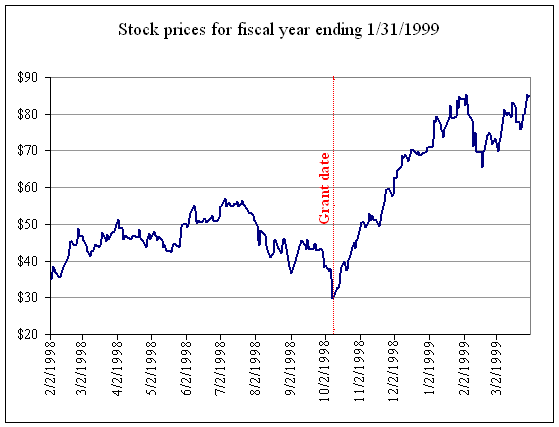
Is backdating of ESO grants illegal?
Backdating of ESO grants is not necessarily illegal if the
following conditions hold:
![]() No documents have been forged.
No documents have been forged.
![]() Backdating is clearly communicated to the company's
shareholders. After all, it is the shareholders who effectively pay the
inflated compensation that typically results from backdating ESOs.
Backdating is clearly communicated to the company's
shareholders. After all, it is the shareholders who effectively pay the
inflated compensation that typically results from backdating ESOs.
![]() Backdating does not violate shareholder-approved option
plans. Most shareholder approved option plans prohibit in-the-money
option grants (and thus, backdating to create in-the-money grants) by requiring
that option exercise prices must be no less than the fair market value of
the stock on the date when the grant decision is made.
Backdating does not violate shareholder-approved option
plans. Most shareholder approved option plans prohibit in-the-money
option grants (and thus, backdating to create in-the-money grants) by requiring
that option exercise prices must be no less than the fair market value of
the stock on the date when the grant decision is made.
![]() Backdating is properly reflected in earnings. For example,
because backdating is used to choose a grant date with a lower price than on
the actual decision date, the options are effectively in-the-money on the
decision date, and the reported earnings should be reduced for the fiscal year
of the grant. (Under APB 25, the accounting rule that was in effect until
2005, firms did not have to expense options at all unless they were in-the-money.
However, under the new FAS 123R, the expense is based on the fair market value
on the grant date, such that even at-the-money options have to be
expensed.) Because backdating is typically not reflected properly in
earnings, some companies that have recently admitted to backdating of options
have restated earnings for past years.
Backdating is properly reflected in earnings. For example,
because backdating is used to choose a grant date with a lower price than on
the actual decision date, the options are effectively in-the-money on the
decision date, and the reported earnings should be reduced for the fiscal year
of the grant. (Under APB 25, the accounting rule that was in effect until
2005, firms did not have to expense options at all unless they were in-the-money.
However, under the new FAS 123R, the expense is based on the fair market value
on the grant date, such that even at-the-money options have to be
expensed.) Because backdating is typically not reflected properly in
earnings, some companies that have recently admitted to backdating of options
have restated earnings for past years.
![]() Backdating is properly reflected in taxes. The exercise
price affects the basis that is used for estimating both the company's
compensation expense for tax purposes and any capital gain for the option
recipient. Thus, an artificially low exercise price might alter the tax
payments for both the company and the option recipient. Further,
at-the-money options are considered performance-based compensation, and can
therefore be deducted for tax purposes even if executives are paid in excess of
$1 million (see Section 162(m) of the Internal Revenue Code). However, if
the options were effectively in-the-money on the decision date, they might not
qualify for such tax deductions.
Backdating is properly reflected in taxes. The exercise
price affects the basis that is used for estimating both the company's
compensation expense for tax purposes and any capital gain for the option
recipient. Thus, an artificially low exercise price might alter the tax
payments for both the company and the option recipient. Further,
at-the-money options are considered performance-based compensation, and can
therefore be deducted for tax purposes even if executives are paid in excess of
$1 million (see Section 162(m) of the Internal Revenue Code). However, if
the options were effectively in-the-money on the decision date, they might not
qualify for such tax deductions.
Unfortunately, these conditions are rarely met, making backdating
of grants illegal in most cases. (In fact, it can be argued that if these
conditions hold, there is little reason to backdating options, because the firm
can simply grant in-the-money options instead.)
How do we know that backdating takes place in practice?
David Yermack of NYU was the first researcher to document some
peculiar stock price patterns around ESO grants. In particular, he found
that stock prices tend to increase shortly after the grants. He
attributed most of this pattern to grant timing, whereby executives would be
granted options before predicted price increases. This pioneering study
was published in the Journal of Finance in 1997, and is definitely worth
reading.
In a study that I started in 2003 and disseminated in the first
half of 2004 and that was published in Management Science in May 2005
(available at http://www.biz.uiowa.edu/faculty/elie/Grants-MS.pdf),
I found that stock prices also tend to decrease before the grants.
Furthermore, the pre-and post-grant price pattern has intensified over time
(see graph below). By the end of the 1990s, the aggregate price pattern
had become so pronounced that I thought there was more to the story than just
grants being timed before corporate insiders predicted stock prices to
increase. This made me think about the possibility that some of the
grants had been backdated. I further found that the overall stock market
performed worse than what is normal immediately before the grants and better
than what is normal immediately after the grants. Unless corporate
insiders can predict short-term movements in the stock market, my results
provided further evidence in support of the backdating explanation.
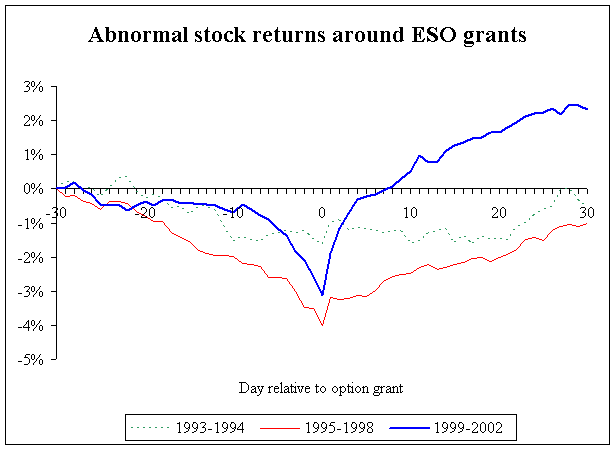
In a second study forthcoming in the Journal of Financial
Economics (available at http://www.biz.uiowa.edu/faculty/elie/Grants-JFE.pdf),
Randy Heron of Indiana University and I examined the stock price pattern around
ESO grants before and after a new SEC requirement in August of 2002 that option
grants must be reported within two business days. The graph below shows
the dramatic effect of this new requirement on the lag between the grant and
filing dates.
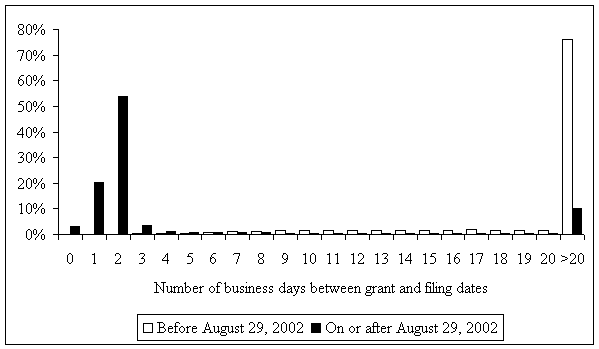
To the extent that companies comply with this new regulation,
backdating should be greatly curbed. Thus, if backdating explains the
stock price pattern around option grants, the price pattern should diminish following
the new regulation. Indeed, we found that the stock price pattern is much
weaker since the new reporting regulation took effect. Any remaining
pattern is concentrated on the couple of days between the reported grant date
and the filing date (when backdating still might work), and for longer periods
for the minority of grants that violate the two-day reporting
requirements. We interpret these findings as strong evidence that
backdating explains most of the price pattern around ESO grants.
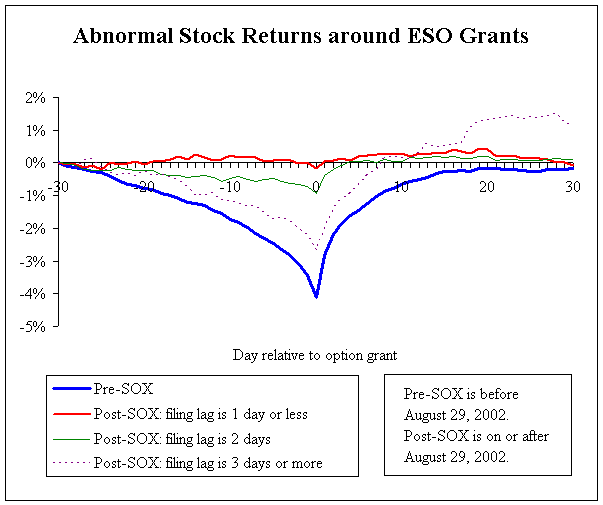
There is also some relatively early anecdotal evidence of
backdating. A particularly interesting example is that of Micrel
Inc. For several years, Micrel allowed its employees to choose the lowest
price for the stock within 30 days of receiving the options. After these
stock option terms came to the attention of the IRS in 2002, it worked out a
secret deal with Micrel that would allow Micrel to escape $51 million in taxes
and required the IRS to keep quiet about the option terms. Remy Welling,
a senior auditor at the IRS, was asked to sign the deal in late 2002.
Instead, she decided to risk criminal prosecution by blowing the whistle.
A 2004 NY Times article describes this case in greater detail (the article is
available here),
and so does a 2006 article in Tax Notes Magazine (available here).
In a 2004 CNBC interview, Remy Welling said that "this particular -- well,
it's called a 30-day look-back plan, is even widespread in Silicon Valley and
maybe throughout the country."
What about spring loading and bullet dodging?
The terms "spring loading" and "bullet
dodging" refer to the practices of timing option grants to take place
before expected good news or after expected bad news, respectively.
Sounds familiar? This is what Professor Yermack hypothesized in his
article discussed above, though he never used these terms. The collective
evidence suggests that these practices play a minor role in explaining the
aggregate stock returns around grants. For example, if spring-loading and
bullet dodging played a major role, we should observe pronounced price
decreases before grants and increases after grants irrespective of whether they
are filed on time, but we don't. Thus, it appears that either (a) spring
loading and bullet dodging are not widespread or (b) these practices typically
fail to lock in substantial gains for the option recipients.
A couple of related notes:
![]() Positive news announcements after grants is consistent with both
spring-loading and backdating. Thus, such news announcements do not
necessarily imply spring-loading.
Positive news announcements after grants is consistent with both
spring-loading and backdating. Thus, such news announcements do not
necessarily imply spring-loading.
![]() The term "forward dating" has also been used to describe
the practice of setting the grant date to occur after predicted future price
declines and/or before predicted future price increases. However, this
term has been used imprecisely in the media. For example, Microsoft's
practice before 1999 of using the lowest market price during the 30 days after
July 1 (which was when the grant was issued) as the exercise price has been
referred to as forward dating. However, this is just a variation of
backdating, because the exercise price cannot be set until the 30 days have
passed, at which point one can look back to see what the lowest price
was.
The term "forward dating" has also been used to describe
the practice of setting the grant date to occur after predicted future price
declines and/or before predicted future price increases. However, this
term has been used imprecisely in the media. For example, Microsoft's
practice before 1999 of using the lowest market price during the 30 days after
July 1 (which was when the grant was issued) as the exercise price has been
referred to as forward dating. However, this is just a variation of
backdating, because the exercise price cannot be set until the 30 days have
passed, at which point one can look back to see what the lowest price
was.
What happens to companies that are caught backdating?
In July 2005, Silicon Valley software company Mercury Interactive
Corp. announced that its board had named a special committee to investigate
past stock-option grants in connection with an informal SEC probe that was
initiated in November 2004. An internal investigation uncovered 49 cases
in which the reported date of a Mercury stock-option grant differed from the
date on which the option appears to have been actually granted. As a
result, three top executives at Mercury, including the CEO, resigned in
November 2005. The stock price fell 25% upon the news of the backdating
instances and the executive resignations. Because the company was unable
to restate the earning to account for the option backdating in a timely manner
and delayed other filings of earnings with the SEC, its shares were delisted in
the beginning of 2006.
Prompted by the Mercury case and other SEC investigations, the Wall
Street Journal (WSJ) ran a big story on the issue of backdating on November
11, 2005 (available here). In a follow-up story, I
supplied the WSJ with data that allowed it to identify six companies as
possible backdaters (available here). The
publication of this article on March 18, 2006 triggered several events among
the identified companies:
![]() Comverse Technology Inc. indicated it will restate more than five
years of financial results and three executives (including the CEO) have
resigned. In addition, federal prosecutors have begun a criminal
investigation of stock-option-granting practices, and a class action lawsuit
has commenced in the United States District Court for the Southern District of
New York on behalf of Comverse stockholders.
Comverse Technology Inc. indicated it will restate more than five
years of financial results and three executives (including the CEO) have
resigned. In addition, federal prosecutors have begun a criminal
investigation of stock-option-granting practices, and a class action lawsuit
has commenced in the United States District Court for the Southern District of
New York on behalf of Comverse stockholders.
![]() UnitedHealth Group Inc. will suspend many forms of its senior
executive pay, including stock options. A shareholder suit (supported by
the Minnesota attorney general) alleges that shareholders were harmed by
backdated option grants.
UnitedHealth Group Inc. will suspend many forms of its senior
executive pay, including stock options. A shareholder suit (supported by
the Minnesota attorney general) alleges that shareholders were harmed by
backdated option grants.
![]() Vitesse Semiconductor Corp. placed CEO Louis R. Tomasetta and two
other top executives on administrative leave and might restate three years of
financial results.
Vitesse Semiconductor Corp. placed CEO Louis R. Tomasetta and two
other top executives on administrative leave and might restate three years of
financial results.
A WSJ article published on May 5, 2006 (available here) summarized some of these events and discussed some of
the effects on shareholders' value. For example, the article suggested
that the market capitalization of UnitedHealth Group dropped $13 billion since
questions about option-granting practices surfaced. The reduced market
capitalization presumably reflects direct effects such as those listed above
and indirect effects such as disruption in operations and consequences of a
tarnished reputation.
How many ESO grants have been backdated?
In a new working paper with Randy Heron, we estimate that 23% of
unscheduled, at-the-money grants to top executives dated between 1996 and
August 2002 were backdated or otherwise manipulated. This fraction was
roughly halved as a result of the new two-day reporting requirement that took
effect in August 2002. However, among the minority of grants that are
filed late (i.e., more than two business days after the purported grant dates),
the prevalence of backdating is roughly the same as before August 2002.
(The fraction of grants that are filed late is steadily decreasing, but in 2005
it was still about 13%.) While a non-trivial fraction of the grants that
are filed on time are also backdated, the benefit of backdating is greatly
reduced in such cases. We also find that the prevalence of backdating
differs across firm characteristics; backdating is more common among tech
firms, small firms, and firms with high stock price volatility. Finally,
we estimate that almost 30% of firms that granted options to top executives
between 1996 and 2005 manipulated one or more of these grants in some
fashion. This amounts to more than 2,000 firms! (Note, however,
that many of these firms no longer exist as independent public firms.)
The complete study is available here.
How many firms will be caught for having backdated grants?
I believe that only a minority of firms that have engaged in
backdating of option grants will be caught. In other words, we will never
see the full iceberg.

There are at least two reasons for this:
![]() Backdating can be hard to identify. First, if a 30-day
look-back period is used when backdating options, the stock price on the purported
grant date will not necessarily be at a low for the period centered on this
date, and there are likely to have been many other prices during the year that
were significantly lower. The four graphs of hypothetical grants below
illustrate this. Second, companies sometimes have a mix of option plans,
some of which might dictate the grants to be scheduled in advance, in which
case the overall evidence of backdating will be murky. Third, firms might
have concealed any traces of backdating by not choosing the absolute lowest
price for the look-back period or by only backdating some of the grants.
Fourth, many of the grants (even at the executive and director level) have
never been filed with the SEC.
Backdating can be hard to identify. First, if a 30-day
look-back period is used when backdating options, the stock price on the purported
grant date will not necessarily be at a low for the period centered on this
date, and there are likely to have been many other prices during the year that
were significantly lower. The four graphs of hypothetical grants below
illustrate this. Second, companies sometimes have a mix of option plans,
some of which might dictate the grants to be scheduled in advance, in which
case the overall evidence of backdating will be murky. Third, firms might
have concealed any traces of backdating by not choosing the absolute lowest
price for the look-back period or by only backdating some of the grants.
Fourth, many of the grants (even at the executive and director level) have
never been filed with the SEC.
![]() Both the regulators and the investment community might be content
to set some precedents based on a limited set of egregious backdating cases to
send a signal that backdating and similar behavior will be punished
severely. In any event, resources will be put in place to improve the
disclosure requirements for option grants and enforce existing regulations.
Both the regulators and the investment community might be content
to set some precedents based on a limited set of egregious backdating cases to
send a signal that backdating and similar behavior will be punished
severely. In any event, resources will be put in place to improve the
disclosure requirements for option grants and enforce existing regulations.
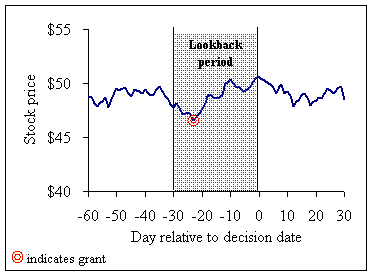
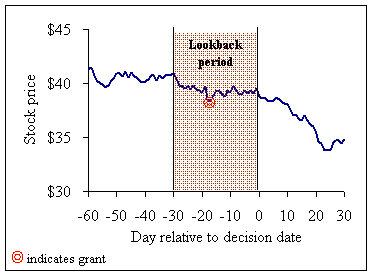
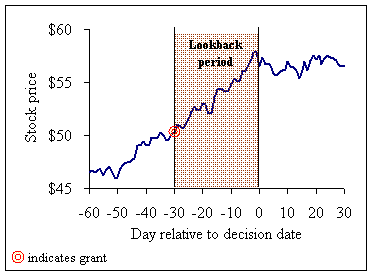
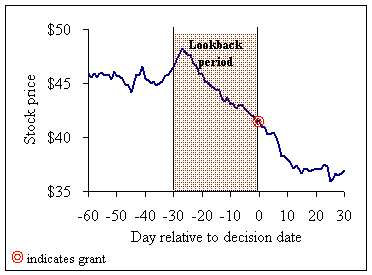
What now?
The SEC, the media, and the investment community will certainly
uncover more cases in the near future. For an updated list, click here.
As the SEC discloses information from its investigations, we are also likely to
learn more about how exactly the backdating was done in various companies and
who was involved in these schemes.
We have also learnt about other transactions that have been
backdated. For example, there is evidence that exercises of options in
which the acquired shares are (i) not sold have been backdated to low prices to
minimize personal taxes and (ii) sold to the company have been backdated to
high prices to maximize the proceeds from the share sales. The graphs
below show stock returns around options exercises in which either no acquired
shares are sold, shares are sold to the company, or shares are sold to a third
party.
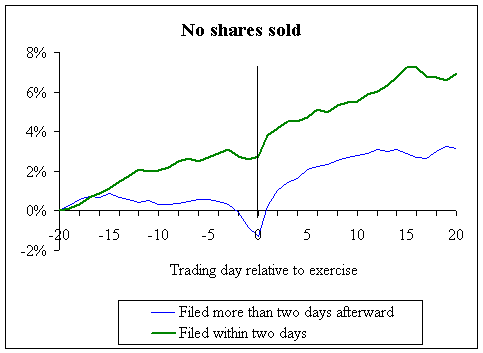
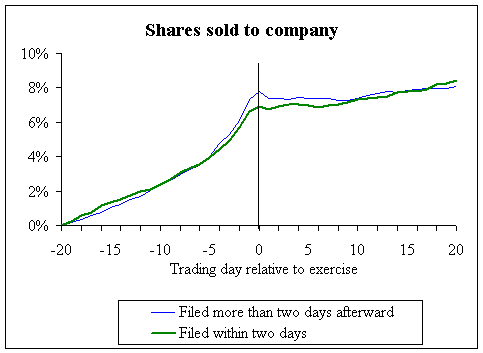
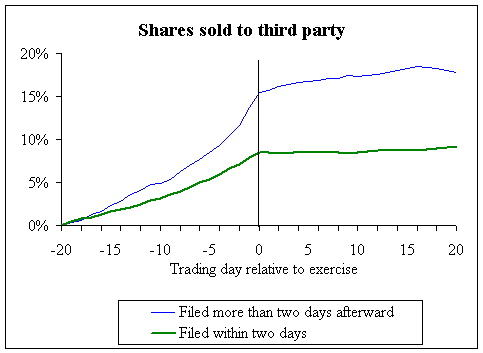
© 2006, Erik Lie, University of Iowa. (For profiles of me, see, e.g.,
the WSJ article available here or the AP article
available here. Also, a copy of my written
testimony at the US Senate Banking Committee is available here.)